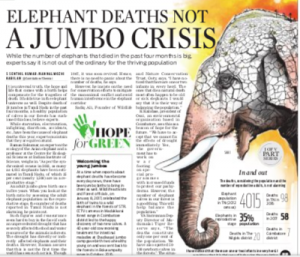Not so sure it is not a jumbo crisis

In a recent article the Indian Express (http://epaper.newindianexpress.com/1207661/The-New-Indian-Express-Coimbatore/15052017#page/2/1), elephant conservationists attempted to reassure the public about the present fate of elephants. The 2016-17 drought has affected farmers, ecosystems and wildlife alike. Among the various impacts of this drought, the noticeable deaths of wild elephants has alarmed the public. Experts explained that mortality is higher during some years which regulates populations, and the above average mortality has positive impact in the sense that it reduces density.
One can only agree that populations are naturally regulated by mortality. However, what none of the experts have said is that Asian elephant populations are small. Whatever their size (4015 for the discussed region in 2012, according to the article), elephants in single populations are no more than the population of a human hamlet. Since mortality may alter the species’ genetics, excessive mortality should always be worrisome and treated as dangerous for an endangered species.
Secondly, experts should emphasize more strongly that elephants don’t live under natural conditions anymore due to loss and fragmentation of their habitat, excessive human disturbance, livestock grazing pressure, invasive species reducing forage, combined with limited access to water and food resources. The “let nature take its course” philosophy is no longer possible because unfortunately we have inherited a wild world that requires our management. A close scrutiny of mortality and the understanding of its cause practically in real time, is required.
Even though it is difficult to put any accurate numbers on mortality before the elephant census is over, the hypothetical doubling of mortality may be symptomatic of new ecological conditions, which the experts failed to mention. We cannot ignore the fact that the drought we just witnessed might be the beginning of climatic extremes that will become more prevalent in the future as predicted by climate scientists. In this case, the supposed excessive mortality would become the norm. Therefore, the public has very good reasons to be concerned about our jumbos.
Priya Davidar.
